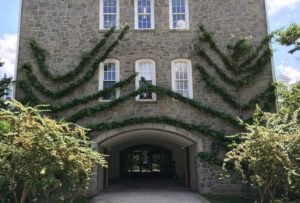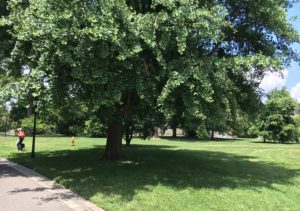Hello fellow readers, A dear friend, Vicki Johnson, sent a Thanksgiving card she made with a beautiful photograph of a maple leaf in its fall glory. On the back, there’s folklore about catching a falling leaf bringing good luck with golden Ginkgo biloba leaves cascading amongst the words. Her card reminded me of Peter Crane’s lecture about his book Ginkgo: The Tree that Time Forgot (Yale University Press 2015), a fascinating biography of the living fossil–a tree that survived the horror of war, and with its resilience comes great lessons of enduring hope for peace.
Ginkgo Trees are its own “Brand.”

The lovely card was made by a dear friend Vicki Johnson
 Crane spoke at an annual Woody Plant Conference, where we learned about new plants that took a dozen or more years from propagation to becoming available in the trades. Plant patents, once rare, are now commonplace. Then there’s Ginkgo biloba, which has its own “brand” —there are no other trees in its botanical classification.
Crane spoke at an annual Woody Plant Conference, where we learned about new plants that took a dozen or more years from propagation to becoming available in the trades. Plant patents, once rare, are now commonplace. Then there’s Ginkgo biloba, which has its own “brand” —there are no other trees in its botanical classification.
Also known as Maidenhair tree after a fern that the leaf resembles, Ginkgoes date back to before the dinosaur age and almost went extinct in the last Ice Age. The oldest one on record lived 3,500 years.
Formerly the Director of the Kew, The Royal Botanic Gardens in London, Peter Crane, explained that the living fossil survived only in China. But when its health benefits became known, it “was brought back from the brink of extinction” about a thousand years ago.
Ginkgo nuts are a delicacy in Asian cultures. And we use extracts as supplements to help a host of conditions, such as memory loss, dizziness, ringing in the ears, hearing disorders, and leg pain associated with poor circulation.
Ginkgoes survived the atomic bomb dropped on Hiroshima.

Ginkgo espalier at The Scott Arboretum, Swarthmore, PA
Peter shared photos of the iconic fan-shaped leaves that turn lemon yellow and drop almost simultaneously, leaving a carpet of gold in the fall, which adds to its “horticultural prominence.” Magnificent espaliers of Ginkgo embrace a stone building, and a large specimen commands the lawn at The Scott Arboretum in Swarthmore, PA, the venue of the conference.
Ginkgoes survived the atomic bomb dropped on Hiroshima, Japan, in 1945, destroying the city and killing 140,000 civilians in retaliation for Japan attacking the United States. The trees burned, but the cambium cell layer, the growing part of the trunks, survived, as did their roots deeply buried in our dear earth. The surviving trees remind us about the ability to emerge from the horror of war, representing a message of hope for peace.
Its extraordinary endurance has become a symbol of longevity, health, and wellness. Ginkgoes are often commemorative trees, such as in the grove on Pier A in Hoboken, NJ, across from where the World Trade Center once stood dedicated to residents who lost their lives in 9-11.

Ginkgo biloba at The Scott Arboretum, Swarthmore, PA
Powerful wisdom we can learn from a tree.
As Peter Crane so eloquently writes, “The evolutionary and cultural life story of Ginkgo connects us to the deep history of our planet. And asks us to reflect more often and think more carefully about all we lose when the short view rules our world and everything in it.” Powerful wisdom we can learn from a tree.
Like the surviving Ginkgo with their inner cambium, we each have an inner light that guides us; we call God, Source, or Higher Power—far more significant than our heritage, country, or family history. We are all one in our world that provides endless opportunities to help one another with kind thoughts, words, and actions— allowing us to spread our inner light. And we each have an internal code of honesty and truth, not judging others or ourselves.
There’s a poem by Sufi poet Hafiz titled No More Leaving that explains the potential of our inner light:
At some point, your relationship with God will become like this: Next time you meet Him in the forest or on a crowded city street, there won’t be any more “Leaving.” That is, God will climb into your pocket; You will simply just take yourself along!
Where there is love, there is enduring hope for peace.
Garden Dilemmas? AskMaryStone@gmail.com and your favorite Podcast App.
Link to Vicki Johnson’s Handcrafted Gifts on Paper
There’s more to the story in Episode 85 of the Garden Dilemmas Podcast:


